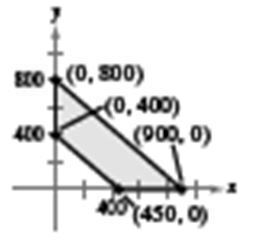
The minimum and maximum values of the objective function and optimal points.
Answer to Problem 12E
The minimum value is 18000 and the maximum value is 3600.
The optimal points are
Explanation of Solution
Given:
Objective function is,
Constraints are:
Calculation:
The area bounded for the given constraints is shown below:

Vertexes of the region are:
Substitute all the points in objective function as follows:
The minimum value is 18000 and the maximum value is 3600.
The optimal points are
Chapter 7 Solutions
EBK PRECALCULUS W/LIMITS
- The evolution of a population of Hippos, R(t), in hundreds, time in years, in an African National Park is given by the equation, dR dt (a) Solve the system exactly for R(t). = R(7 – R); R(0) = 3 2 (b) What happens as the time t → ∞o, i.e. what is the population a long time in the future? (c) Write an Euler scheme and compute until the population levels off (using Excel, Matlab, Octave, LibreCalc or similar). Do it twice, once with At = 0.1 and once with At = 0.05. (d) Plot all of your solutions on the same set of axes and comment.arrow_forwardfind For triangle ABC, with vertices A = (3,-1,2), B = (-5,4,-4) and C = (6, −1, −1), (a) the length of side AB, (b) the equation of the line that passes through A and B, (c) the angle at vertex B, (d) a vector perpendicular to the plane containing the triangle ABC, (e) the area of the triangle ABC. (f) the equation of a plane passing through A, B and C.arrow_forwardShowing all working, use the row reduction method to find the inverse of B, given by 5 -1 B = -3 1 3 1 -3 2arrow_forward
- Consider the matrix A, given by +63) A = 1 -3 4 -3 4 5 -105 (a) Find the determinant of the matrix, A. (b) Find all possible solutions, x, to the system Ax = b, where b is the column vector, (1,2, −4).arrow_forwardIf a (1,4,2) and b = (−1, −5,3), find |a|, a + b, 3a - 2b, a b, a x b and b × a. What is the angle between a and b?arrow_forwardShowing all working, find the eigenvalues and corresponding eigenvectors of -3 (a) (27) 6arrow_forward
- Showing all working and using row operations determine all solutions to the follow- ing system of equations. 2x + 3y-2z = 8, -2x+y+6z= 12, -x+3y-2z = −4.arrow_forward8:38 *** TEMU 8 5G. 61% Score on last try: 0 of 1 pts. See Details for more. > Next question Get a similar question You can retry this question below Give the equation for the function which would have graph shown below. Use f(x) for the output. 54 3 2 1 12-11-10 -8 -7 -6 -5 -4 -3 -2 -3 23456 -4 -5 -6 -2 f(x) = 3 sin ( 7/7 x ) +2 Question Help: ☑Video ☑Message instructor Submit Question ||| <arrow_forward2:21 MM -8 -7 -6 -5 -4 0 5 4 3 2 N -3 -4 +5 +6 5G 100% Identify the function whose graph appears above. f(x) = = tan X 3 ✓ Question Help: ☐ Video ☐ Message instructor Submit Question |||arrow_forward
 Calculus: Early TranscendentalsCalculusISBN:9781285741550Author:James StewartPublisher:Cengage Learning
Calculus: Early TranscendentalsCalculusISBN:9781285741550Author:James StewartPublisher:Cengage Learning Thomas' Calculus (14th Edition)CalculusISBN:9780134438986Author:Joel R. Hass, Christopher E. Heil, Maurice D. WeirPublisher:PEARSON
Thomas' Calculus (14th Edition)CalculusISBN:9780134438986Author:Joel R. Hass, Christopher E. Heil, Maurice D. WeirPublisher:PEARSON Calculus: Early Transcendentals (3rd Edition)CalculusISBN:9780134763644Author:William L. Briggs, Lyle Cochran, Bernard Gillett, Eric SchulzPublisher:PEARSON
Calculus: Early Transcendentals (3rd Edition)CalculusISBN:9780134763644Author:William L. Briggs, Lyle Cochran, Bernard Gillett, Eric SchulzPublisher:PEARSON Calculus: Early TranscendentalsCalculusISBN:9781319050740Author:Jon Rogawski, Colin Adams, Robert FranzosaPublisher:W. H. Freeman
Calculus: Early TranscendentalsCalculusISBN:9781319050740Author:Jon Rogawski, Colin Adams, Robert FranzosaPublisher:W. H. Freeman
 Calculus: Early Transcendental FunctionsCalculusISBN:9781337552516Author:Ron Larson, Bruce H. EdwardsPublisher:Cengage Learning
Calculus: Early Transcendental FunctionsCalculusISBN:9781337552516Author:Ron Larson, Bruce H. EdwardsPublisher:Cengage Learning





